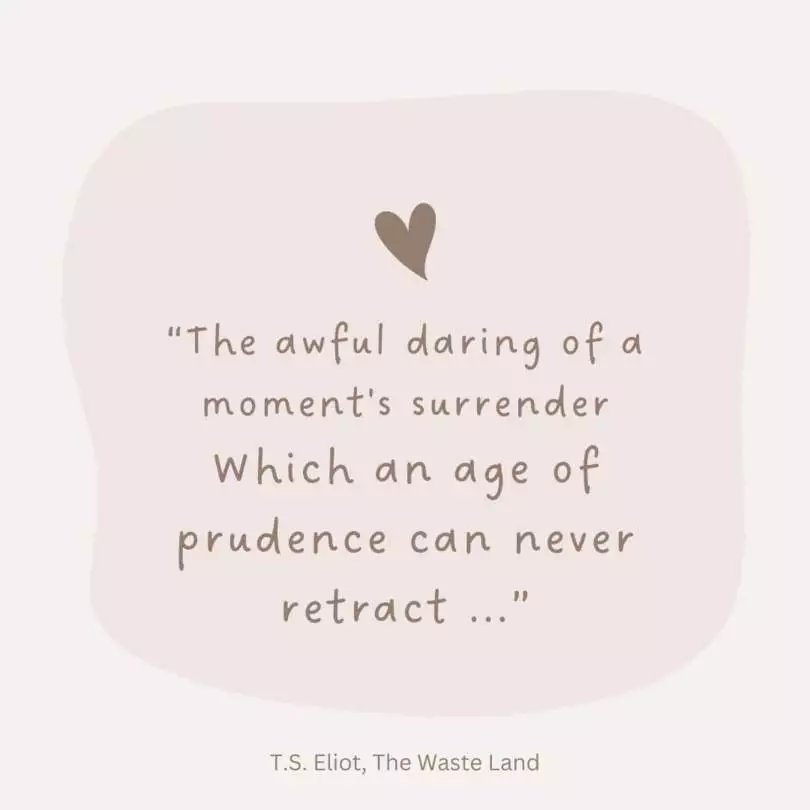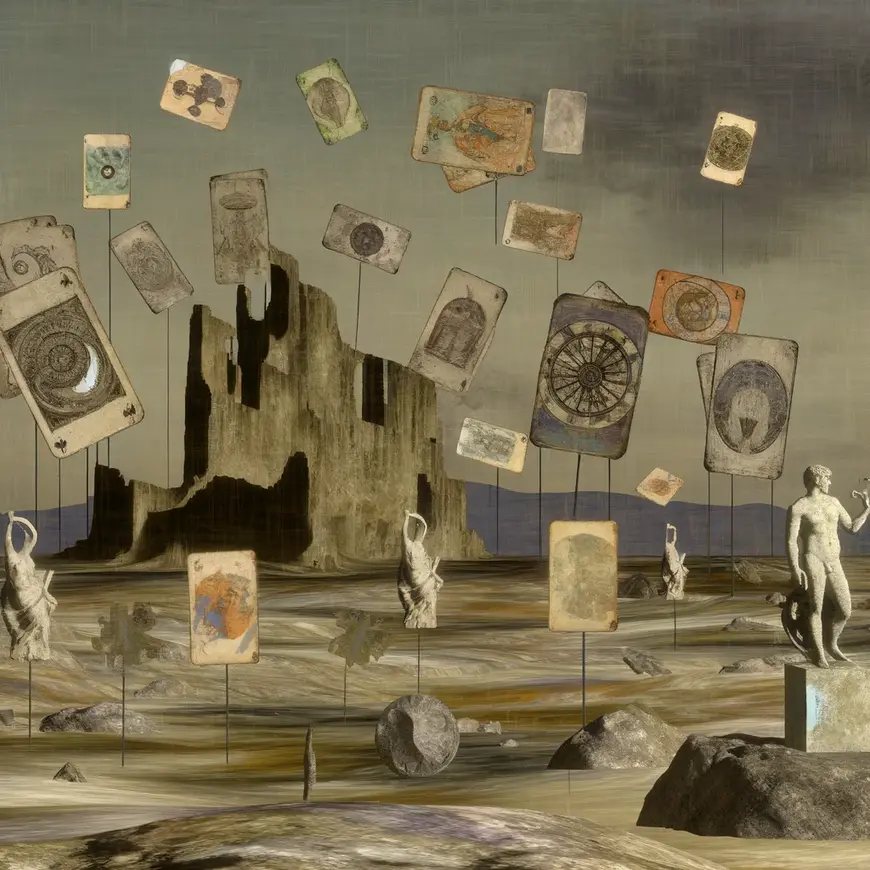T.S. Eliot’s “The Waste Land”: A Literary Odyssey Through the Fragmented Landscape of Modernity
In the kaleidoscope of literary brilliance, T.S. Eliot‘s “The Waste Land” stands as a monumental journey through the shattered landscapes of modernity. Prepare to embark on a poetic odyssey that navigates the ruins of civilization, plunging deep into the recesses of the human psyche. Eliot, a literary alchemist, weaves a tapestry of fragmented voices, cultural allusions, and spiritual yearning, inviting readers to decipher the enigmatic verses that echo the complexities of a world in disarray.
The Desolation Chronicles: Deciphering Eliot’s Waste Land
“The Waste Land” unfolds as a series of desolation chronicles, capturing the essence of a world scarred by the aftermath of war and the disillusionment of the modern era. Eliot’s poetry, characterized by its fragmented structure and interwoven voices, mirrors the fractured nature of a society grappling with the ruins of tradition and the uncertainty of the future.
The title itself, borrowed from the Fisher King myth and the Arthurian legend, sets the tone for the desolation that permeates the poem. Eliot invites readers to traverse this wasteland, a symbolic landscape fraught with cultural decay, spiritual desolation, and a pervasive sense of disillusionment.

Fragmentation as Art: The Collage of Voices in “The Waste Land”
Eliot’s innovative use of fragmentation emerges as a central feature of “The Waste Land.” The poem resembles a literary collage, piecing together fragments of diverse voices, languages, and cultural references. From the classics to modern pop culture, Eliot’s verses become a melting pot of human expression, echoing the cacophony of a world besieged by conflicting narratives.
The poem’s fragmented structure mirrors the disintegration of conventional forms and the breakdown of established norms. Readers encounter a mosaic of voices, from the mythical Tiresias to the contemporary clerk, creating a chorus that captures the multiplicity of perspectives within the collective human experience.
The Modern Wasteland: A Reflection of Post-War Despair
“The Waste Land” emerged in the aftermath of World War I, a period marked by profound social, cultural, and political upheaval. Eliot’s poem becomes a mirror reflecting the collective despair and disillusionment that characterized the post-war era. The wasteland is not merely a physical space but a metaphor for the emotional and spiritual desolation pervading society.
Eliot’s depiction of the modern wasteland extends beyond the physical ravages of war to encompass a broader landscape of moral decay, fractured identities, and the erosion of cultural values. The poem resonates with the collective trauma of a generation haunted by the horrors of conflict and the subsequent search for meaning in a world that seemed to have lost its bearings.
Mythology and Religionin “The Waste Land” : The Quest for Redemption
Within the fragmented verses of “The Waste Land,” Eliot interweaves threads of mythology and religious symbolism, creating a tapestry of spiritual yearning and existential quest. The Fisher King, the Sirens, and the biblical allusions imbue the poem with a timeless quality, connecting the modern wasteland to archetypal narratives of redemption and renewal.
The mythic elements serve as anchors in the turbulent sea of Eliot’s poetry, offering glimpses of transcendence amid the desolation. The quest for spiritual renewal becomes a leitmotif, inviting readers to ponder whether redemption is attainable in a world plagued by fragmentation and moral decay.
Cultural Allusions: A Literary Feast of References
Eliot’s intellectual prowess shines through the multitude of cultural allusions scattered throughout “The Waste Land.” From Shakespeare to Dante, from the Upanishads to contemporary literature, the poem becomes a literary feast that challenges readers to unravel layers of meaning and draw connections across diverse traditions.
The rich tapestry of cultural references serves not only as a testament to Eliot’s erudition but also as a commentary on the interconnectedness of human experience. “The Waste Land” invites readers on a literary scavenger hunt, urging them to decipher the mosaic of allusions that contribute to the poem’s intricate web of meaning.
The Burial of Tradition: Critique of Modernity
Eliot’s critique of modernity permeates “The Waste Land,” as he grapples with the erosion of cultural traditions and the disintegration of societal norms. The poem becomes a burial ground for the remnants of a bygone era, where the ideals of love, spirituality, and cultural continuity lie entombed beneath the weight of modern disillusionment.
Eliot’s lamentation for the lost connection to tradition echoes throughout the poem. The invocation of the Fisher King myth, with its themes of woundedness and infertility, becomes a poignant metaphor for a society grappling with the consequences of abandoning its cultural roots.
Sexual Symbolism: The Wasteland of Human Intimacy
Amid the ruins of tradition, Eliot explores the theme of sexual disillusionment and the erosion of human intimacy. The poem delves into the emptiness of modern relationships, the fragmentation of desire, and the spiritual desolation that accompanies the commodification of love.
The sexual imagery in “The Waste Land” is often stark and disconcerting, reflecting the poet’s critique of a society that reduces profound human connections to mere transactions. Eliot’s exploration of sexual symbolism adds another layer to the wasteland metaphor, underscoring the hollow nature of modern relationships.

Water and Drought: Symbols of Cleansing and Barrenness
Water, in its various forms, emerges as a powerful symbol in “The Waste Land,” representing both cleansing and barrenness. From the river Thames to the mythical river Styx, water becomes a recurring motif that mirrors the cyclical nature of life, death, and renewal.
The imagery of drought and aridity adds to the desolate atmosphere of the poem, highlighting the absence of spiritual nourishment in the modern wasteland. Eliot’s use of water symbolism invites readers to contemplate the possibility of rebirth and rejuvenation in a world parched by spiritual thirst.
Eliot’s Voice: A Polyphony of Perspectives
“The Waste Land” is not a monologue but a polyphony of voices, a collective expression of the human condition. Eliot, as the orchestrator of this literary symphony, weaves his voice into the chorus of fragmented perspectives. His own experiences, beliefs, and cultural influences meld with the diverse voices that populate the poem.
Eliot’s voice, though elusive and enigmatic, becomes a guiding thread through the labyrinthine verses. His role as both poet and participant in the wasteland narrative adds a personal dimension to the poem, inviting readers to consider the intersection of the author’s voice with the cacophony of voices within the text.
Notable Quotes from “The Waste Land” by T.S. Eliot
- “April is the cruellest month, breeding / Lilacs out of the dead land, mixing / Memory and desire, stirring / Dull roots with spring rain.”
- Explanation: This famous opening line subverts the traditional view of April as a month of renewal and hope. Instead, Eliot portrays it as cruel because it awakens memories and desires in a barren, desolate world, symbolizing the painful revival of life and emotion in a spiritually dead society.
- “I will show you fear in a handful of dust.”
- Explanation: This line emphasizes the theme of decay and desolation. The imagery of dust evokes the transience of life and the inevitability of death, suggesting that even the smallest remnants of existence can inspire profound fear and existential dread.
- “These fragments I have shored against my ruins.”
- Explanation: This quote reflects the poem’s structure, which is composed of fragmented and disjointed pieces. It suggests an attempt to preserve meaning and coherence amidst personal and cultural collapse. The speaker tries to piece together a sense of identity and purpose from the remnants of a broken world.
- “The Unreal City / Under the brown fog of a winter dawn.”
- Explanation: This line describes a bleak and dehumanized urban landscape, likely representing London. The “Unreal City” conveys a sense of alienation and disconnection, capturing the fragmented and impersonal nature of modern life. The imagery of fog and dawn adds to the sense of obscurity and uncertainty.
- “Who is the third who walks always beside you? / When I count, there are only you and I together / But when I look ahead up the white road / There is always another one walking beside you.”
- Explanation: This quote references the phenomenon of the “third man,” which has been interpreted as a spiritual or psychological presence. It suggests an unseen companion or guiding force, reflecting themes of isolation, companionship, and the search for meaning. The ambiguity of the “third” figure adds to the poem’s mystique and depth.
Trivia Facts about “The Waste Land”
- Publication Year: “The Waste Land” was published in 1922. It is considered one of the most important poems of the 20th century and a central work of modernist literature.
- Influence of World War I: The poem reflects the disillusionment and fragmentation of post-World War I Europe. Eliot’s depiction of a spiritually barren and desolate landscape echoes the widespread sense of loss and disorientation experienced during this period.
- Use of Multiple Languages: “The Waste Land” includes lines in several languages, including English, French, Italian, German, and Sanskrit. This multilingual approach reflects the poem’s themes of cultural fragmentation and the search for universal meaning.
- Mythological and Literary References: The poem is rich with allusions to classical mythology, religious texts, and literary works. References include the Fisher King from Arthurian legend, the Bible, Dante’s “Divine Comedy,” and Shakespeare. These allusions create a dense and layered text that invites deep analysis and interpretation.
- Editing by Ezra Pound: Ezra Pound, a close friend and fellow poet, played a significant role in shaping “The Waste Land.” Pound’s extensive edits helped streamline and refine the poem, earning him Eliot’s gratitude, which he expressed in the dedication: “For Ezra Pound: il miglior fabbro” (the better craftsman).
Eliot’s Legacy “The Waste Land” : A Modernist Masterpiece
“The Waste Land” stands as a cornerstone of modernist literature, a masterpiece that continues to resonate with readers and scholars alike. Eliot’s impact on the trajectory of 20th-century poetry is immeasurable, and “The Waste Land” remains a touchstone for those exploring the boundaries of linguistic innovation, cultural critique, and existential inquiry.
The poem’s enduring legacy lies in its ability to evoke both admiration and bewilderment. Eliot’s linguistic experimentation, cultural depth, and profound insights into the human condition have secured “The Waste Land” as a literary landmark that transcends its time, inviting each generation to unravel its mysteries anew.
Conclusion “The Waste Land” : Navigating the Wasteland of Modern Consciousness
In “The Waste Land,” T.S. Eliot invites readers on a journey through the wasteland of modern consciousness, a landscape marked by fragmentation, disillusionment, and the echoes of cultural ruins. The poem’s enduring relevance lies in its capacity to mirror the perennial challenges of the human experience, offering a reflection of societal decay while gesturing towards the possibility of renewal.
Eliot’s linguistic innovation, cultural richness, and exploration of existential themes make “The Waste Land” a poetic odyssey that transcends the boundaries of conventional expression. As readers navigate the fragmented verses, decipher cultural allusions, and confront the desolation chronicled within, they become participants in a timeless exploration of the human spirit grappling with the complexities of the modern world. In the vast wasteland of Eliot’s creation, readers discover not only the ruins of tradition but also the perennial quest for meaning and renewal that defines the human condition.
More Reviews of Works by T.S. Eliot
“The Hollow Men” by T.S. Eliot: A Profound Exploration of Modern Despair and Spiritual Crisis A quick summary of my…
